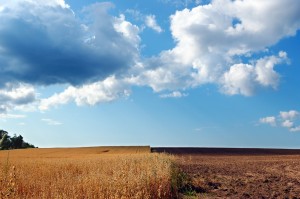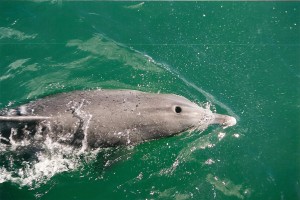Worldlog Settimana 43 – 2013
Il giorno 16 ottobre era la giornata mondiale dell’alimentazione. 57 Giorni dopo Earth Overshoot Day, il giorno in cui quest’anno abbiamo superato quest’anno la capacità riproduttiva della terra e abbiamo realizzato un nuovo deficit ecologico da record Il giorno 16 ottobre un miliardo di persone è andato a letto con fame. Non perché non si produce abbastanza cibo. La terra offre abbastanza per i bisogni di tutti. Ma oltre il miliardo di affamati ci sono un miliardo di persone che sono in sovrappeso.

Siamo di fronte ad una distribuzione molto distorta di cibo e di forme di sfruttamento che ancora nella nostra generazione causerà grave carenza, fra le altre cose, di acqua potabile, fosfato e biodiversità. Inoltre dobbiamo anche tener conto della scarsità di alimenti per animali da cattivi raccolti dovuti a nostra negligenza per quanto riguarda il clima.
La ricerca dell’Università del Minnesota ha evidenziato il mese scorso che c’è speranza per una popolazione mondiale in crescita, a condizione che la politica è cambiata notevolmente. Con la superficie delle colture attuali saremmo in grado di sfamare oltre 10 miliardi di persone, a condizione che non sprechiamo più le colture per mangimi e biocarburanti.
Il settore zootecnico occupa in tutto il mondo 80% di tutti i terreni agricoli. L’eccessivo consumo e produzione di proteine animali non solo provoca obesità e malessere per gli animale qui, ma anche fame e devastazione nel resto del mondo. Tutt’ora si taglia su larga scale la foresta tropicale per la coltivazione di massa di foraggio. La produzione di carne è quindi responsabile del 30% della perdita di biodiversità a livello mondiale.
In uno studio sul futuro dell’industria zootecnica olandese indica che il nostro stile di vita richiederebbe quattro Pianti Terra se il resto del mondo copiasse il nostro modello di consumo. Scommettere su una agricoltura sana, vicino a casa, può richiudere i cicli delle materie prime ancora una volta, ridurre la nostra dipendenza alimentare e fornire al mondo un esempio sostenibile. Un’agricoltura effettivamente sostenibile ristabilisce la connessione tra il consumatore e il produttore di alimenti, e assicura che gli agricoltori ricevono un prezzo equo per un prodotto giusto.
Il governo olandese dovrà agire per fare capire che coltello e forchetta sono le armi principali nella lotta contro i cambiamenti climatici, perdita di biodiversità e la sofferenza degli animali.
Nel mio Worldlog della settimana 40 ho raccontato del succeso di fermare le uccisioni di delfini sulle Isole Faroer. Questa settimana ci sono anche buone notizie per i delfini in Giappone. La nostra mozione, che chiede al governo Olandese di farsi forte a livello internazionale per porre fine alle annuali uccisioni di massa di delfini a Taiji (Giappone) è stata accolta!
Ogni anno a Taiji (ed alle Faeroer) migliaia di delfini vengono portati assieme. Gli animali uccisi sono uccisi in modo barbaro, concludendosi in una carneficina. Il Giappone ha una grande quota in questa battute, per vendere delfini selvatici per tanti soldi agli acquari con delfini, acquari marini e a programmi turistici per il nuoto con questi animali. Gli altri delfini, circa 23.000 delfini ogni anno, sono uccisi per la loro carne.

La caccia commerciale sulle balene è illegale, ma piccoli cetacei, tra cui i delfini, non sono ancora inclusi nella protezione della Commissione baleniera internazionale (IWC). Grazie alla nostra mozione che è stata accolta il governo ora si deve impegnare in un ampliamento del regime di protezione della IWC, attraverso il quale anche la caccia ai piccoli cetacei può essere affrontate.
Clicca qui per il trailer del nuovo film di the Blackfish. Questo film devi vedere!
E guarda qui o leggi qui sulla fantastica azione dell’artista Banksy: Sirens of the Lambs!
Alla prossima settimana!
On 16 October it was World Food Day. 57 Days after Earth Overshoot Day, the day on which we exceeded the reproductive capacity of the earth this year and hit a new record ecological budget deficit. On 16 October one billion people went to bed with hunger. People are not hungry because too little food is produced. The earth offers enough for everyone’s needs. But next to those one billion hungry people are one billion people who suffer overweight.

We contend with a distorted division of food and forms of exhaustion, which, in our generation, will lead to scarcity of drinking water, phosphate and biodiversity among other things. Furthermore, we have to watch out for a possible shortage of cattle food due to poor harvests as a result of the neglect of our climate.
Research of the University of Minnesota showed us last month that there is definitely hope for a growing world population, on the condition that the policy will be substantially changed. With the current arable farming area we should be able to feed more than 10 billion people, provided that we do not waste harvests on cattle food and biofuel.
Cattle farming on a global basis takes up 80% of all agricultural lands. The excessive animal protein consumption and production do not only cause serious overweight and animal suffering here, but also hunger and destruction in the rest of the world. The tropical rain forest is still cut down on a large scale for the massive production of cattle food. As a result, the production of meat is accountable for 30% of the global biodiversity loss.
A study into the future of Dutch animal husbandry indicates that we would need four globes to fit our lifestyle when the rest of the world takes over our consumption pattern. Aiming for healthy agriculture, close to home, may close the raw materials cycle again, reduce our food dependency and give the world an example of good sustainability. A true sustainable agriculture will repair the connection between the consumer and the food producer and will ensure that farmers get a fair price for a fair product.
The government will have to encourage the Netherlands to consider knife and fork as the most important weapons in the fight against climate change, biodiversity loss and animal suffering.
In my Worldlog of week 40 I told you about the successful stopping of dolphin slaughter on the Faroe Islands. This week we also have some good news for the dolphins in Japan. Our motion, which calls the Dutch government to advocate internationally for an end to the annual mass slaughter of dolphins at Taiji (Japan), was adopted!
Each year thousands of wild dolphins are driven together at Taiji (and the Faro Islands). The animals are killed in a barbaric way, resulting in one big bloodbath. Japan has a great share in these drives, so that they can sell wild dolphins for a lot of money to dolphinariums, sea aquariums and touristic programmes for swimming with these animals. The other dolphins, approx. 23,000 dolphins per year, are slaughtered for their meat.

Commercial hunting of whales is illegal, but small cetaceans, including dolphins, have still not been included in the protection programme of the International Whale Commission (IWC). Thanks to our adopted motion the government now has to aim at expansion of the protection regime of the IWC, so that the hunting of small cetaceans can also be tackled.
Click here for the trailer of the new film of the Blackfish. This film is highly recommended!
And look here or read here about the wonderful action of artist Banksy: Sirens of the Lambs!
Until next week!